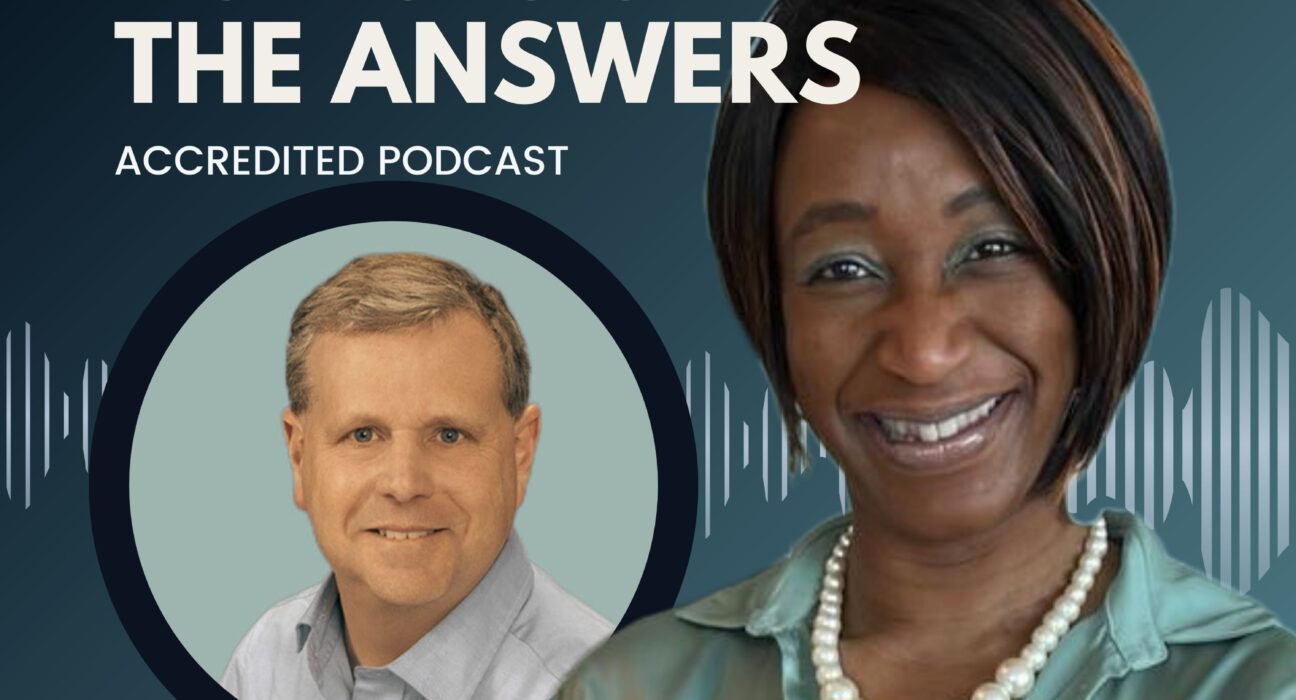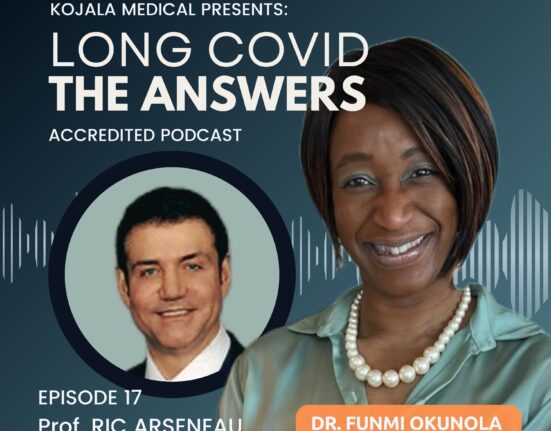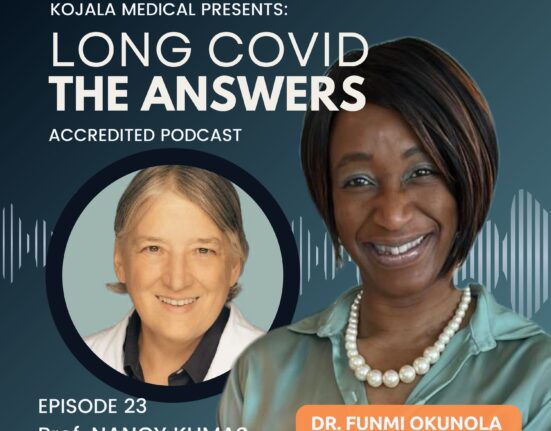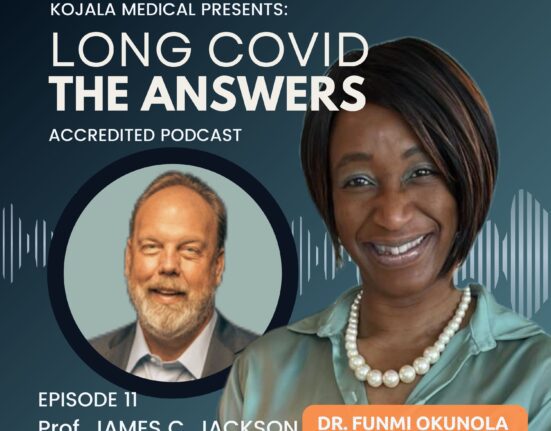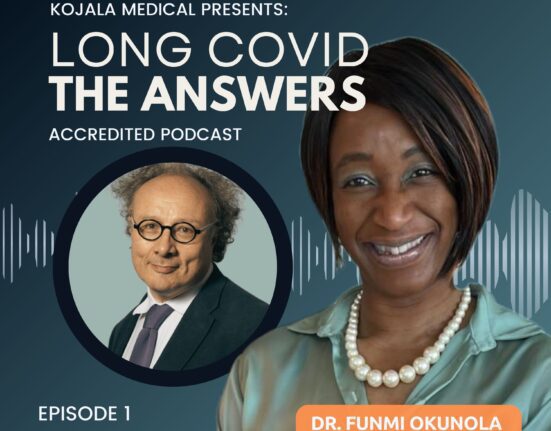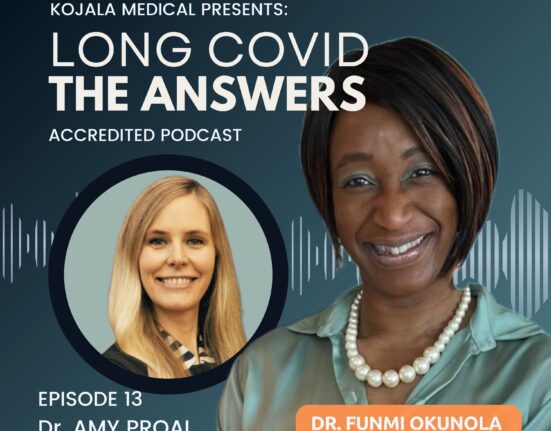
Exploring the complex impact of Long COVID, this podcast ft. Prof David Cutler from Harvard University, delves into the ongoing health challenges, workforce implications, and the critical need for improved healthcare solutions in the U.S.
Guest – Professor David Cutler
Note: The podcast has no bias. All conflicts of interest are highlighted with individual guests.
Healthcare Professionals | Earn 0.5 Certified Mainpro+® Credits! Please register/login to claim your CPD/ CEU credits.
Podcast Overview:
In a podcast episode titled “Economic Cost of Long COVID,” Professor David Cutler from Harvard University discusses the significant economic impact of Long COVID. He explains how Long COVID affects the economy through lost health (reduced quality and length of life), decreased productivity due to individuals being unable to work as effectively, and increased medical costs. Cutler estimates the total economic cost of Long COVID in the U.S. at approximately $3.7 trillion, based on cases up to a year ago. He also highlights that the number of Long COVID cases has grown, which could further elevate the economic burden.
Patients often stop seeking help for Long COVID because they feel unsupported, leading to uncertainty about their recovery status. Although new cases emerge, keeping the numbers steady, it’s unclear if these patients are returning to work or if they remain less effective. Studies suggest that about 40% of Long COVID sufferers may not recover, as seen in SARS-CoV-1 cases. Current data, such as the U.S. Household Pulse Survey, indicates that around two-thirds of Americans who experienced Long COVID have recovered. The situation underscores the need for better studies and support systems to manage Long COVID, especially in the labor force.
Highlights:
- Overview of Long COVID’s significance and impact.
- Chapter 1: Understanding Long COVID:
- What is Long COVID?
- Common symptoms and long-term effects.
- Chapter 2: Health Care Challenges:
- How Long COVID strains the U.S. healthcare system.
- Gaps in diagnosis and treatment.
- Chapter 3: Economic and Workforce Impacts:
- Effects on the labor market and economy.
- Challenges for affected workers and employers.
- Chapter 4: Personal Stories:
- Interviews with Long COVID patients.
- Real-life experiences and challenges.
- Chapter 5: Policy and Advocacy:
- Current policies addressing Long COVID.
- Advocacy for better healthcare and support.
DISCLAIMER: The information in this podcast is provided for informational purposes only. You should not use any information discussed in this podcast and related materials to make medical or healthcare related decisions. Always consult a your physician or other qualified health care provider with regards to diagnosing managing your medical condition. Any medications or treatments, including any discussed in this podcast, should be initiated and managed by a qualified health care professional.
Podcast Transcript:
Healthcare Professionals: Please note to claim Certified CPD / CEU credits toward your medical license (Canada & reciprocal CPD/CEU Worldwide), you will need to register or log in.
Episode 9 – The Economic Cost of Long COVID ft. Professor David Cutler
This interview was recorded on 17th January 2024
[00:00:00] Funmi Okunola: The information in this podcast is provided for informational purposes only. You should not use any information discussed in this podcast and related materials to make medical or healthcare related decisions. Always consult your physician or other qualified healthcare provider with regards to diagnosing and managing your medical condition. Any medications or treatments, including any discussed in this podcast should be initiated and managed by a qualified healthcare professional.
Funmi Okunola: Welcome to Long Covid-The Answers. Today’s Episode is the “Economic Cost of Long Covid”. I would like to introduce you all to Professor David Cutler, the Otto Professor of Applied Economics at Harvard University in the U.S.A. Professor Cutler served on the Council of Economic Advisors and the National Economic Council during the Clinton administration, and has advised the presidential campaigns of Bill Bradley, John Kerry and Barack Obama, as well as being senior healthcare advisor for the Obama presidential campaign. Currently, Professor Cutler is a Research Associate at the National Bureau of Economic Research and a member of the National Academy of Medicine in the USA.
Welcome.
David Cutler: Thank you. It’s great to be with you.
Funmi Okunola: David, do you have any conflicts of interest that you want to declare?
David Cutler: I don’t have any conflicts of interest related to the Long COVID issue at all. [00:01:00]
Funmi Okunola: Great! and out of interest, what is an Otto Eckstein professor?
David Cutler: So that’s the name of the Professorship. Otto Eckstein was a very famous economist, and his work was about learning from data about the economy. He developed one of the first macro-economic models of the economy. So, in many ways this is quite fitting because I believe that he would have been very interested in issues like how does disease and in particular Long COVID affect the economy?
Funmi Okunola: Thank you for that. This podcast interview is based around the widely cited articles that Professor Cutler has written, namely “The COVID-19 pandemic and the $16 trillion virus, a viewpoint published in the Journal of the American Medical Association, also known as JAMA, in October 2020, and his article, “The Costs of Long Covid”, published in JAMA Health Forum in July 2022. As [00:02:00] listeners should know by now the links to all articles will be provided with the podcast. Professor Cutler, what inspired you to write both of these articles?
David Cutler: Of course, COVID was an enormous health shock, but it was also a huge economic shock, and so part of what inspired me to write these articles was wanting to get some sense about how big the economic shock of COVID was. Not that it was bigger than the health shock, but it has enormous implications for the economy.
So, I thought that it would be interesting to explore them, and just as with medical care where there’s not like a single number you can say, okay, this is the number that is the health impact. There’s not a single number you can say, okay, this to the dollars and cents is the cost of COVID, but it helps to get a scale for how big it is. Is it really big? Is it moderately big? Is it not so big? That can then influence what policy actions are appropriate now or to prevent future potential [00:03:00] pandemics.
Funmi Okunola: Yeah, great work. Before we move on to examine your findings, I’d like you to provide a definition of QALYs or Quality Adjusted Life Years for our audience, as I believe this will help people who aren’t familiar with the term.
David Cutler: So, when we think about how much a disease affects people’s health, you want to say, “Well, how does it affect both the length of life (that is how long they can expect to live) and the quality of those years? So, will they be high quality or low quality?”
For example, a disease that improves quality of life counts towards a higher value of life, even if it doesn’t extend life. So, what the quality concept does, (people always abbreviated quality or often abbreviated quality), is it takes the remaining years of life, so, life years, and then it adjusts them for the likely quality of those lives in a case like COVID or Long COVID. That’s particularly important because it has both implications for the length of life, [00:04:00] and implications for the quality of life. What I do in both of these papers is I try and say how much is in one case- COVID in the other case Long COVID likely to affect the quality adjusted life years or the years of life adjusted for the quality of those years that people have.
Funmi Okunola: Thank you. Could you please explain to the audience what a ‘statistical life’ is and how it is calculated.
David Cutler: Yes. Qualities are in years – like how many years of quality adjusted life can I expect to have? If I want to add up different kinds of economic costs associated with Long COVID or with COVID, some of the costs are economic costs, like people are not working, some are medical costs, like the money we’re not spending on medical care or the money we are spending on medical care. It’s very hard to add up dollars on medical care with years of life loss. I need some way to value those [00:05:00] years of life in dollars so then I can add up everything in dollars and get a dollar total. The way that economists typically do that is they ask the question, “How much would a typical person be willing to pay to reduce the risk of disease”?
A classic example would be how much would I be willing to pay for an airbag in a car? An airbag is not for sure going to save my life, but with some probability it’ll save my life, and from that I can get an estimate about how much people value kind of statistical lives. That is, I know it’ll save the life of one in 10, 000 drivers.
I don’t know who that one will be, but how much am I willing to pay to save the life of one in 10, 000 drivers. That’s not too dissimilar from how much would I be willing to pay to prevent a disease that would kill one in 10,000 people. So, the statistical life is basically saying, okay, how much are people willing to pay given their incomes to [00:06:00] reduce the probability that a typical person would die or suffer a quality-of-life impairment, and then value changes in quality of life, like for example, the impact of Long COVID on quality of life by that statistical value of a life.
Funmi Okunola: The current estimated number of people suffering from Long COVID coverage in the U.S. is thought to be around 5.3% of the population at approximately 18 million cases. Can you please explain the estimated loss to the economy in terms of a statistical life and quality with these figures?
David Cutler: Yeah, so you had the figures about exactly right which is roughly 5%, about 5% of Americans are currently suffering from Long COVID.
In terms of the economic aspect of Long COVID for the economy as a whole, I divided it into three parts. The first is the lost health – that is people living longer and less long and lower quality [00:07:00] years, and I valued those using the methodology we were talking about with the value of a statistical life.
The second is people who are unable to work as much or as productively as they were, so people who are out of the labor force, more who are not as productive on the job is the second part, and then the third part is the additional medical spending associated with caring for people with Long COVID, which I guess would be like spending on Chronic Fatigue Syndrome.
That’s pretty brutal which is a common manifestation similar to Long COVID. So, what I did was I took all the COVID, and all the Long COVID cases we knew of as of, say a couple of years ago, and then said, “How much would that, if you play it out over people’s remaining lives, how much would that cost the economy?” and the answer to that was about 3.7 trillion dollars. That is, that was the cost just [00:08:00] of cases up to about a year or so ago.
3.7 trillion, and it was the sum of those three components.
Funmi Okunola: Yeah, and a couple of years ago the number of people with Long COVID was 9 million, wasn’t it? So, are we looking at double 3.7 trillion now?
David Cutler: That would lead to it being higher. There are also other things that are important like, for example, how long will people live with Long COVID? That, I think the answers are coming in a little bit less long than we had feared, which is good news. That is, people seem to be recovering from Long COVID, on average a little bit faster than we had thought. So, there are things that are turning out obviously to be different than what when forecast, probably on both sides.
Funmi Okunola: But I spoke to Professor Danny Altman recently, and the number of people suffering from Long COVID in a population, I guess he’s mostly looking at [00:09:00] the UK, seems to stay the same, though paradoxically in America, it seems to have gone up.
Therefore, if people are getting better, truly, and I don’t know if we have true figures for that because at the moment the reason for this whole podcast series is because the medical profession knows very little about it. My day-to-day colleagues and friends who are GPs know very little about it. I think that it’s very underdiagnosed. There’s not enough adequate treatment. So, people stop asking their doctors, they stop coming to us for help because we’ve not been very forthcoming. I don’t know whether people are recovering or just simply no longer reporting.
The second thing is that new people are joining the ranks, so the numbers seem to be staying the same. I don’t know whether there’s been any studies to indicate whether people have gone back to work, maybe not working as much or as efficiently as they did, but now feel that they’re good enough, and about 40% of people seem to not get better. If we look [00:10:00] at the SARS-CoV-1 study done in Canada, the vast majority of people who developed Long COVID from that never got better. How do you feel about that?
David Cutler: So, the estimates are very, very hard to know as you said. In the U.S. the best data that we have comes from the Household Pulse Survey. That data asks people “Have you ever experienced symptoms of Long COVID?” which it defines for them as symptoms lasting beyond when you had COVID, and then “Are you currently experiencing symptoms of Long COVID?” So about 15% of Americans say they’ve never had symptoms of Long COVID – American adults, and about 5% of American adults say they’re currently experiencing symptoms.
So, if you take those at face value, about two thirds of American adults who ever experienced Long COVID then have recovered from it, they say they’re not currently experiencing. [00:11:00]
Funmi Okunola: Hmm, true.
David Cutler: That rate of recovery over about two years or so, when I had done those forecasts, I guess, based partly on SARS-CoV-1, that the average case would last about five years.
Here I think the average case is coming in below five years. So, as I said that is a little bit of data suggests that was too pessimistic an assumption. But of course, both the data are subject to biases and reporting, and it may differ for different kinds of people in different settings and so on.
So, it just comes back. The truth is very hard to know here, but Lord willing, hopefully people are recovering faster than at least I had feared they would recover.
Funmi Okunola: I’m sorry to go on about this point, but the numbers have gone up from two years ago from 9 million to 18. [00:12:00] What’s the reflection on that with regards to your figures?
David Cutler: Yeah, people come into the population of having it as they have COVID, and so as more and more people get re-exposed or exposed the first time to COVID, that adds to the share of people with Long COVID. It’s kind of there’s a flow in and think of it like a bathtub – there’s a flow in and a flow out and the water comes in and then the water goes down. So, when the total amount is going up then there’s more water coming in than there is water going down, which is unfortunate. That doesn’t tell you how rapidly the flow is going down, which is what you want to know in terms of how rapidly people are recovering from Long COVID.
Funmi Okunola: Okay. I guess we’ll know that over years to come.
David Cutler: Hopefully if we get some good population studies of it, you know, the UK has very good studies and the U.S. are okay, but hopefully as we get better studies, we’ll really get a good handle. There’s also recovery is not just a zero one, of course, it’s – I can work some, but I can’t work [00:13:00] fully, and I’m not as bad as I was, but I’m not as good as I was before COVID either. So, it’s not a zero one process either.
Funmi Okunola: Okay. People who suffer from Long COVID work and earn less, and the majority of sufferers in the Western world are working aged women between the ages of 36 and 50 years. What effects do you believe this has on the labour force as a whole and the healthcare labour force in particular?
David Cutler: It’s a very good question. It has a very big impact. One of the things that we’ve seen in the U. S. that has been seen in other countries as well is we’re having a lot of difficulty staffing service jobs. So, these are jobs like restaurants and cafes and hotels and medical care because it’s an in-person kind of job.
Of course, a lot of the medical care labor force is female, and a fair amount of the service [00:14:00] sector labor force from hotels to medical care to education and so on would have been at higher risk for COVID because of the in-person nature of the contact. So, at least in the U.S., and I think in other countries, there’s a part of, if you will, the missing labor force, which is likely to be people who had COVID and developed Long COVID who are then out of the labor force, or they don’t have it but someone in their family does, and they’re caring for them, or they’re doing other things to offset someone having Long COVID.
So that was really, really bad in the U. S. probably about a year to two years ago. It’s eased somewhat as people who had been burned out and discouraged have come back in the labor force. But there still is likely a decline. You still find that restaurants, hotels, many health care sectors, particularly the long-term care sector, still having a [00:15:00] lot of difficulty hiring workers. Those are probably some people who are out with Long COVID – not all. There are many, many other things that are going on, but at least one of them is probably Long COVID shrinking the labor force.
Funmi Okunola: Important point. Could we talk about the potential loss of income as a result of that?
David Cutler: Yes, the loss of income is very severe, and it matters in two ways.
The first is to the family itself. So, the family loses the paycheck that was coming in or part of the paycheck that was coming in. In most countries, there is some type of social insurance system to offset that. So, it may have been the direct stimulus payments during COVID, would be a disability insurance program and other context in other countries, it would be temporary disability in the U.S. or [00:16:00] permanent disability, depending on the nature of the illness. So, the family loses money, part of which is offset by the social insurance system. For society the loss is the fact that you’ve lost the person’s income, so when we were talking about the cost of COVID I mentioned that part of the cost of COVID was the lost productivity.
The other parts, the disability insurance and so on, those are transfers from some people who, thankfully, are still working and healthy, to other people who are not in the labor force, either for Long COVID or for other reasons. Those transfers don’t reduce GDP, they don’t affect how much total there is in the economy. But they take money from some people and give it to others. The total social loss is the fact that there are people who would like to work, who were able to work, who now no longer can.
Funmi Okunola: What concerns me [00:17:00] is that we’ve got in the West an aging population, and I know at some point, if it hasn’t happened already, two thirds of adults will be over 55 in Europe, and I presume North America and the rest of the West, and we’re losing a whole huge proportion of people that can’t work because they’re suffering from Long COVID, and therefore not contributing tax dollars to sustain our economy. So, what do you think all of this will have with regards to our aging population on our economy?
David Cutler: Yeah, so most Western countries, the U. S. is on the least end of this, but all Western countries are aging quite rapidly. So, finding ways to keep people at work longer was a big deal before COVID and is now an even bigger deal afterwards. One of the things that is helpful about COVID is that remote work has opened a lot of possibilities. For people who could only work part time before [00:18:00] remote work enables them to work more part time, and for many people who were disabled and out of the labor force because commuting to work was very difficult, telework jobs make it be possible to go back to work. Ironically, one of the things that we’ve seen in terms of increased labor supply is that people with disabilities are more likely to be at work now than they were before COVID.
All of which is to say that the employment situation has both an ability to work, that is, can you work? and is the labor market set up so that you can work? and one of the big issues for employers is finding ways that people with Long COVID or other conditions can still meaningfully work, even if they can’t do, if you will, 100%. One example of that is, you know, some employers require some mobility at [00:19:00] work. Okay, fine. So, one of the common stories that I hear is people with Long COVID who have difficulty climbing stairs. Well, so maybe you can reconfigure the job so that that person doesn’t have to climb stairs, and maybe someone else can do the climbing of the stairs. Is there some other way to get things up and down the stairs? Once you make that change, it’s not a big change, but once you make that change, all of a sudden, you’ve now increased someone’s ability to do the job, and so those kinds of accommodations are going to become really crucial.
They’ve become crucial because of COVID and Long COVID, and continuing up with that is going to be really crucial so that we’re able to maximize the productivity of everyone who can work.
Funmi Okunola: That’s a really excellent point, and something positive that’s come out of this horrible pandemic that we’re having to now think about disabled people more because Long COVID sufferers, a lot of them are disabled.
So, therefore maybe we’ll be able to [00:20:00] bring people that were disabled who weren’t able to work into the workforce if employers are properly supported to do so. That’s a really good perspective and something positive.
David Cutler: It is. So, you know, I try and look for the silver lining in some of this, but it really is that if you can do something from home now and you can save two hours of commuting time and a very difficult commute for some people, that, that’s going to allow some people to work who would not have otherwise been able to, and that’s a great thing for them, their family and society.
Funmi Okunola: Yeah, yeah, that’s good. Can you talk a little bit more about the medical costs of treating Long COVID?
David Cutler: Yeah, the medical sector is not very well set up in the U. S. as in most countries, to treat Long COVID – Chronic Fatigue Syndrome, which is probably the closest, the sort of feeling that you’re in a fog and so on.
In the U.S., we used to dismiss it with the term ‘yuppie fever’. [00:21:00] So that was yuppies working too hard and, so on. Of course, now what we’ve learned is that it’s not yuppie fever, it’s a very serious condition, and of course, Long COVID. It is a very serious condition. The medical system is not very well set up to treat people with Long COVID.
Now part is…there are very different manifestations of Long COVID. Sometimes it shows up in the cardiovascular system. So you need cardiologists, or the respiratory system, and you need pulmonologists, or so on. But then sometimes it’s in the realm of primary care, and what we need is primary care doctors who feel as comfortable treating Long COVID as they do treating Diabetes or let me call it minor mental illnesses that are reasonably standard in primary care. Some people need to be sent onto a specialist because the situation is very bad, but others can be treated in primary care, and the problem with having just specialists is there’s no way to get enough of them. [00:22:00] You know if every person with Diabetes needed to see a cardiologist, we would run out of cardiologists well, well, well before we had exhausted the population in every country.
So, you have to be able to treat people at the primary care level at least as long as you can manage that, and that medical system is going to have to get to a point where primary care doctors and nurses and so on feel comfortable treating many cases of Long COVID, not all of them, because very severe cases are going to have to go to specialists, but many cases of Long COVID need to be able to be treated in primary care.
Funmi Okunola: Yeah, that’s an excellent point, and I guess that will keep costs down. The whole point of this podcast series is that I’ve spoken to colleagues across the board, and they just really don’t have any idea of how to approach it. We’ve been talking about this in Canada, and it’s become apparent to me as a family physician that we [00:23:00] need a multi-disciplinary setup in primary care.
At the moment. Everything’s dumped on the family physician. You’re a social worker, you’re a psychiatrist, you’re a multiple specialist, there’s just so much complexity, often expected in 7-10 minute consultations and Long COVID sufferers need more time and they need that multidisciplinary support, say with a nurse, an occupational therapist, a social worker, a physiotherapist working in conjunction with us. That’s were general practice needs to change. How do you think about that?
David Cutler: Almost everything consequential in life is done by teams, not individuals. Sports are team sports not individual sports. Innovation, design, new scientific knowledge is done by teams, not just individuals. The idea of the lone individual sitting in their lab discovering something is not true now, even if it ever was true and I’m not sure it ever was true. So the whole idea of medicine has to be around the idea of the team helping to care for people, not the individual doctor whose responsibility it is.
For some things the doctor can be fine, but that doctor needs to be able to have a team in place as you mentioned. Psychiatrists, behavioural health workers, nurse practitioners for the less severe cases, specialists for the more severe cases, and that team has to be able to function together, and the worry is that if you dump it all on one doctor that one doctor just literally can’t handle it all.
So, things are going to fall through the cracks. I am a very, very big believer that medicine has to be done in a team fashion and Long COVID, I think, brings that out in many ways because the symptoms can be all over the map, and so you really can’t – no one is going to be an expert in all of those symptoms, or [00:25:00] conversely, if you’re an expert in Long COVID there’s just no way you can see all the patients who need to be seen, so you’ve got to have a teamwork approach to this, and that’s what the good approach is.
Health systems will do is to try to figure out how do we bring all of our resources together at the right time in the right specialization to care for the patient, not just how do I get this one doctor to do it.
Funmi Okunola: David, you just make such excellent points, and you’ve given me a really positive angle on looking at this.
We could really, if Long COVID was, properly recognized and taken seriously in the medical profession, it could help change the whole way primary care is delivered that will benefit all. This is something I’ve been harping on about for ages, and what is really driving people in my profession out of it, because everything’s dumped on one individual, and I think we’re partially to blame for that in trying to be heroes. But then again, everything’s changed from the 50s to [00:26:00] now, there’s just so much more you can do in medicine, and primary care just quite hasn’t caught up. But yeah, thank you for those excellent points.
What are your thoughts on how we can reduce the massive economic losses you’ve attributed to Long COVID?
David Cutler: A couple of points about what we can do. One is, as we were talking about, employers can help by trying to reconfigure jobs, using people who can only do telework through telework, figuring out what people can do, and having them do that as opposed to insisting they do things they can’t do.
The second responsibility is the government’s responsibility, and that is to do lots more research on how people with Long COVID are faring, what kinds of therapies would be helpful, what sequencing of things and so on will be most helpful. So, population studies combined with bio-medical studies to learn about the best ways of treating Long [00:27:00] COVID.
Third is we were talking about the medical system, and the medical system has to think about how it as a system wants to address Long COVID, not just how each individual clinician wants to address Long COVID, because there’s no way that any individual clinician can just add that on top of what they were doing and expect to be able to do a good job.
Funmi Okunola: Excellent point.
David Cutler: And I would say the fourth issue is because the costs of Long COVID are so big as are the costs of acute COVID. We need to do everything we can to prevent recurrent epidemics, and that means investing worldwide in the kinds of things that will lead to healthier populations, less likelihood of infectious disease spreading, earlier notification when it does, more actions to help prevent people. So, in some things we did very well, like developing vaccines quickly, other [00:28:00] things we did awfully in terms of preparing populations and so on. So, learning from this so that the next time we don’t face the situation again is another important area.
Funmi Okunola: Yeah, thank you. Why do you think governments around the world are ignoring the economic impacts of Long COVID?
David Cutler: It’s interesting, because people got so focused on the death totals from COVID, right? You know, how many people were dying of COVID, and then when those numbers went down, people had a tendency to want to forget the people who survived were not all the same as they were before. Then, at least in the States, it got caught up in this sort of political issue about did we overreact? So if you have, for whatever reason, the political orientation that we overreacted, then saying, well, no, “Long COVID is a big deal” doesn’t fit with that. [00:29:00]
So, between the focus on the acute disease, which at the time was appropriate, but not the exclusive focus, and the sense of, oh, no, I need to show that I’m in favor of the economy and not what the public health practitioners say, all of that conspires to push Long COVID to the back.
Then I think the bio-medical research folks in the medical system have not stepped up to say, no, no, no, you can’t do this to Long COVID any more than you can say to people who are living with AIDS, tough luck with HIV, who are HIV positive, tough luck, we don’t care about you anymore.
Like, we understand you can’t do that for people who are HIV positive, but we haven’t reached the same place for people with Long COVID.
Funmi Okunola: Yeah, learning about this disease has really opened my eyes to others, and made me rethink about other post-viral illnesses.
I didn’t even realize that HIV had a whole swathe of post-viral illnesses. So hopefully, myself and others and you are trying to wake up the medical profession to acknowledge that.
David Cutler: [00:30:00] At least in the U.S. we’ve been much better about caring for people with HIV because we understand they need to be on lifelong medication, and we have programs to do that and so on, but you know, even still, there’s this tendency to want to say, “Oh, no, let’s forget. We don’t need to worry about this disease anymore”. When that’s just not true.
Funmi Okunola: In the beginning of your 2020 article, the COVID-19 pandemic and the 16 trillion virus you state that the SARS-CoV-2 pandemic is the greatest threat to prosperity and well being the U.S. has encountered since the Great Depression.
You also state that your figures are based on the optimistic assumption that it will be substantially contained by the fall of 2021. Given that we are in the second biggest wave of coronavirus infections due to the variant JN1, currently estimated in the U. S. alone as 2 million per day, causing approximately 7,000 to 8,000 deaths per month in the U.S., what do you think the true cost of this pandemic is now?
David Cutler: It’s interesting, [00:31:00] like what we were talking about with Long COVID, there have been some things that have been worse than we forecast, and some things that have been better. So, the things that have been worse is of course the disease keeps going on, and we’re in the midst of another wave now, and God knows how many more there will be, and that’s just horrible.
The thing that’s better is the U.S. did not go through a very prolonged slump because of COVID. So, unlike in say 2010, when the economy spiraled and we went through a very long recession, very tough recession, the great recession, people call it here, there was certainly some adjustment problems, but actually the economy has done very well and credit to fiscal authorities, credit to monetary authorities that have done a much better job here than they had done in the past. So, I don’t have an updated number in my mind for what the number is now. [00:32:00] Unfortunately, COVID is still around, but fortunately our management of the economic consequences of COVID has been better than I had feared it would be.
Funmi Okunola: That’s interesting. Okay. I know we’ve run out of time. We could probably go on for another hour. You brought up so many interesting topics. I hope you’ll come back for an interview when you republish or update on this whole topic because we’d love to speak to you again. Your articles have been, as I say, widely cited in other research papers. Thank you for your very excellent work. That’s why I wanted to invite you.
David Cutler: I just constantly keep popping up. Thank you for having me.
Funmi Okunola: Oh, no, it’s been a pleasure and an honor, Professor Cutler. Please keep up the very excellent work.
David Cutler: Thank you. Thank you so much.
Funmi Okunola: Some questions for listeners to consider.
What are your top five takeaways from this episode?
How will this episode change your practice or perception of this disease?
What will you do to act on what you’ve learned?
Please discuss your thoughts on our social media outlets such as Twitter or X, our website blog, Instagram, Facebook, LinkedIn.
Please rate this episode.
SHOW NOTES:
THIS PODCAST WAS RECORDED ON THE 17th JANUARY 2024
Professor David Cutler, the Otto Eckstein Professor of Applied Economics at Harvard University in the U.S.A., research associate at the National Bureau of Economic Research and a member of the National Academy of Medicine in the USA talks about the economic cost of Long COVID.
REFERENCES
2 Cutler DM, Summers LH. The COVID-19 pandemic and the $16 trillion virus. Jama. 2020
3 Cutler DM. The economic cost of long COVID: an update. Publish Online July. 2022.


